How did the World War II impact Americans at home?
Unlike more recent conflicts where the U.S. relied on a volunteer army, World War II engaged the efforts of the entire civilian population. All males between the ages of 18 to 35 had to register for the draft. Rationing of food, gasoline, tires and clothing required life style changes. With American soldiers fighting on two fronts around the globe, families and friends anxiously awaited for reports of the war's progress and casualties.
War Effort in Iowa
American agriculture supported not only our own troops but the military and civilian populations of our Allies. Food rationing and victory gardens at home made more resources available for Great Britain, Russia and other military partners. Farmers managed to produce more livestock, grains, cotton and other supplies in the face of worker shortages due to the military call-up of farm labor. New farm equipment was in short supply as factories shifted to tanks, jeeps and armaments, but farmers learned to repair and share existing machinery. Women also stepped into farm production and management roles in place of husbands, fathers and sons. In Iowa, the Extension Service at Iowa State provided valuable information to farm families and relayed information from Washington on wartime regulations and best farming practices.
Moving into full wartime production required a quick expansion of the labor market in the face of the loss of males heading into service. To fill the gap, the American government and factories made a push to encourage women to take jobs they had never held before. "Rosie the Riveter" was a campaign that praised women who took manufacturing positions once reserved for men. Patriotic appeals to women to support the troops helped to overcome traditional views of women's place as in the home raising children. However, while patriotism was one motivation, the higher paychecks from factory work were more persuasive. Still, traditional views of women’s role in the home and raising children kept the government from providing government day care or domestic assistance to ease women's wartime burden.
Negative Side Effects of War
One ugly product of war is that it encourages combatants to demonize the enemy. Japanese-American families on the West Coast were forced into internment camps just because of their ethnicity. The U.S. Supreme Court even upheld the order citing the need to protect the country against espionage. In Iowa, there was much less sympathy for Germany than in World War I because of the negative opinions toward Adolf Hitler, but public sentiment threatened any expressions of pro-German attitudes with swift retribution. Furthermore, opposition to government policies or refusal to support war efforts were seen as potential evidence of disloyalty. While sincere patriotism ran high, many people conformed to wartime demands from fear of drawing charges of letting down our troops.
While it was difficult to protest unfair treatment during the war, several groups pressed for more favorable policies after the war. At the University of Iowa, returning African-American veterans demanded the right to live in university dormitories that they had been denied before the war, and the university ended its segregation policies. Three Des Moines activists successfully picketed Katz Drug Store to end its practice of denying service to African Americans. President Harry Truman ended segregation in the armed forces in 1948 against strong opposition from southern politicians. In 1954, the U.S. Supreme Court ruled in Brown v. Board of Education that segregated schools were unconstitutional, a milestone in civil rights. Women did not fare as well. Many labor unions allowed returning veterans to take the jobs of female wartime workers even when women protested that they had served effectively in those positions. Women were encouraged to put the needs of veterans first and sacrifice their own interests.
World War II engaged the entire population unlike any conflict since. Whether in the military or the civilian population, war needs came first and people were encouraged to support them by both positive rewards and threats for refusal.
Supporting Questions
In what ways did food help win the war?
- People Waiting in Line for Sugar Rations in America, between 1942 and 1945 (Image)
- Girl Scouts Planting a Victory Garden, between February and March 1943 (Image)
- U.S. Employment Agent Writing Contracts for Pickers at an FSA Agricultural Workers' Camp, July 1942 (Image)
- Woman Seated on Tractor Pulling Farm Machinery, ca. 1939 (Image)
How did American women fight the war at home?
- "This is America: Keep It Free" Propaganda Poster, 1942 (Document)
- Woman Working on the Motor of a B-25 Bomber, October 1942 (Image)
- Women Wipers Cleaning a Giant "H" Class Locomotive in Clinton, Iowa, April 1943 (Image)
- African-American Women Welders at the Landers, Frary and Clark Plant, June 1943 (Image)
- "I'm Proud ... My Husband Wants Me To Do My Part" Propaganda Poster, 1944 (Document)
How did our fear of the enemy aboard affect how we treated each other at home?
- Executive Order 9066: Resulting in the Relocation of Japanese, February 19, 1942 (Document)
- "I am an American" Sign in Oakland, California, March 1942 (Image)
- Japanese-Americans Waiting to be Evacuated and Forced into Internment to Owens Valley, April 1942 (Image)
- Official Information Bulletin for Internment Camp in Poston, Arizona, May 29, 1942 (Document)
- Editor Ray Takeno and Group Reading Manzanar Paper in California Relocation Center, 1943 (Image)
- Excerpts from Korematsu v. United States, 1944 (Document)
- Interview with Japanese-American Veteran Norman Saburo Ikari, December 2003 (Video)
How effectively were groups able to use the message the US gave for fighting in WWII to gain rights at home?
- "Why Should We March" Flyer, 1941 (Document)
- Executive Order 8802: Prohibition of Discrimination in the Defense Industry, June 25, 1941 (Document)
- Women Working at the Pacific Parachute Company in San Diego, California, April 1942 (Image)
- Iowa Public Television's "An Iowan Joins the Tuskegee Airmen During World War II | First Lieutenant Luther Smith," 2006 (Video)
- Public School Children Buying War Bonds in Chicago, Date Unknown (Image)
| World War II: Homefront Teaching Guide |
| Printable Image and Document Guide |
People Waiting in Line for Sugar Rations in America, between 1942 and 1945
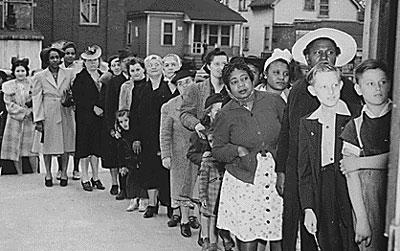
Description
Rationing of goods was important on the homefront during World War II. Because of the war, Americans did not have access to certain goods, such as sugar. To provide context, American civilians only had access to six teaspoons of sugar a day during World War II, while the…
Girl Scouts Planting a Victory Garden, between February and March 1943
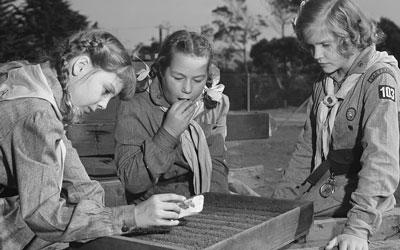
Description
Victory gardens have been a symbol of American support for the war effort and were vital to ensuring individuals at home had access to adequate food while rations were sent abroad. This was a practice used during World War I and was necessary to bring back in World War…
U.S. Employment Agent Writing Contracts for Pickers at an FSA Agricultural Workers' Camp, July 1942
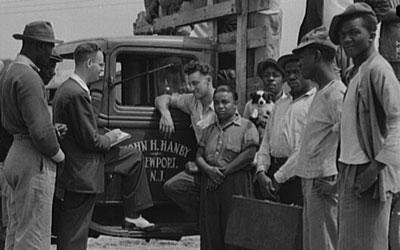
Description
The Farm Security Administration (FSA) was created during the Great Depression in 1937 under the Department of Agriculture with the purpose of helping with rural rehabilitation, farm loans and subsistence homestead programs. How the FSA fulfilled its mission was to create a…
Woman Seated on Tractor Pulling Farm Machinery, ca. 1939
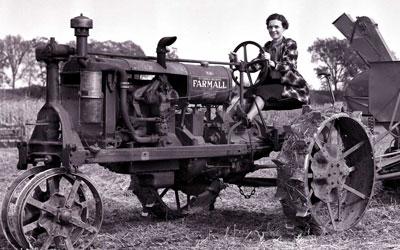
Description
The photograph shows a woman working on the farm during World War II. During this period, many women worked in agriculture as part of the Women's Land Army or Farmerettes. The group started in World War I as a response to the labor shortage from men leaving to fight the…
"This is America: Keep It Free" Propaganda Poster, 1942
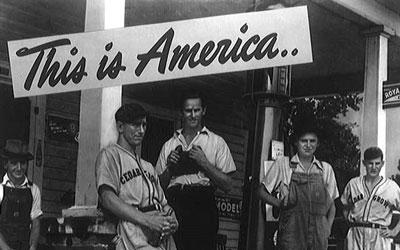
Description
Dorothea Lange was best known for her iconic images of the Great Depression, but she also was responsible for this propaganda poster at the beginning of the war. Along with images like this, she was also hired by the War Relocation Authority to document Japanese internment…
Woman Working on the Motor of a B-25 Bomber, October 1942
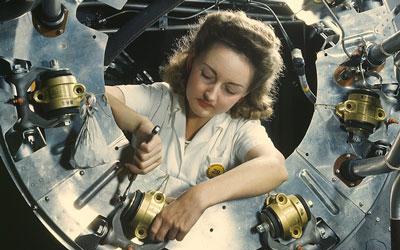
Description
The iconic image of Rosie the Riveter is maybe what most Americans think of when discussing the contributions of American women on the homefront. The work of these women in defense plants and related industries was vital to both the war effort and challenging perceptions of…
Women Wipers Cleaning a Giant "H" Class Locomotive in Clinton, Iowa, April 1943
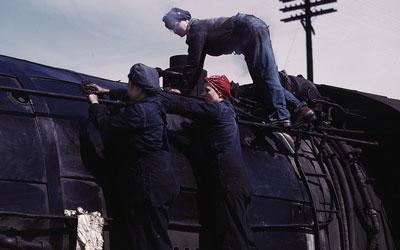
Description
Often the focus of women's work during World War II on the homefront has been in the factory. The photograph shows another way women supported their country by keeping the railroads open and various resources, such as food or weapons, moving across the country. The image was…
African-American Women Welders at the Landers, Frary and Clark Plant, June 1943

Description
African-American women faced extra hurdles to employment in defense industries until Executive Order 8802, which banned discrimination in the job sector. Even after this order was issued, African Americans faced discrimination and…
"I'm Proud ... My Husband Wants Me To Do My Part" Propaganda Poster, 1944
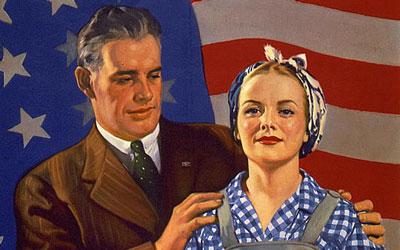
Description
Given the increase in servicemen to 2.2 million during World War II, the need for labor was high. Recruitment of women into jobs became part of the War Manpower Commission, which added a women's advisory committee made up of prominent women tasked with promoting enlistment…
Executive Order 9066: Resulting in the Relocation of Japanese, February 19, 1942
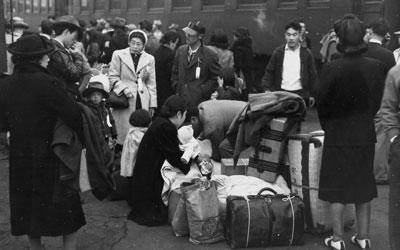
Description
Envy over economic success combined with distrust over cultural separateness and long-standing anti-Asian racism turned into disaster when the Empire of Japan attacked Pearl Harbor on December 7, 1941. Lobbyists from western states, many representing competing economic…
"I am an American" Sign in Oakland, California, March 1942
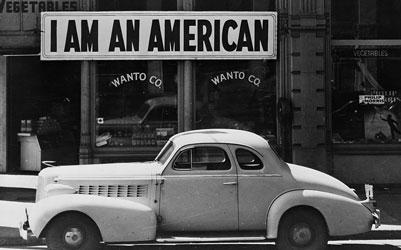
Description
Without due process, the government gave everyone of Japanese ancestry living on the West Coast only days to decide what to do with their houses, farms, businesses and other possessions. Most families sold their belongings at a significant loss. Some rented their properties…
Japanese Americans Waiting to be Evacuated and Forced into Internment to Owens Valley, April 1942
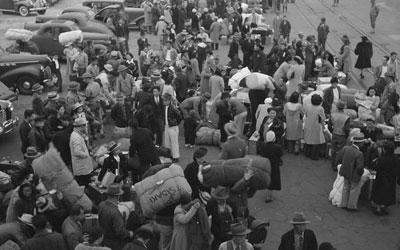
Description
This photograph depicts the harsh reality of the starting point of internment. Each family was assigned an identification number and loaded into cars, buses, trucks and trains, taking only what they could carry. Japanese Americans were transported under military guard to 17…
Official Information Bulletin for Internment Camp in Poston, Arizona, May 29, 1942
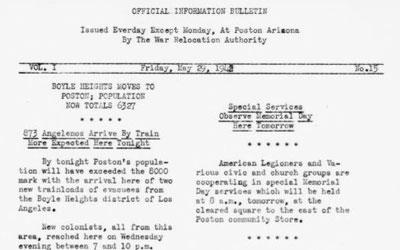
Description
This daily bulletin comes from the Poston relocation camp in Arizona. A unique feature of this camp, besides its size, was that it was built on a Native American reservation. The camp was overseen by both the War Relocation Authority and the Office of Indian Affairs. This…
Editor Ray Takeno and Group Reading Manzanar Paper in California Relocation Center, 1943
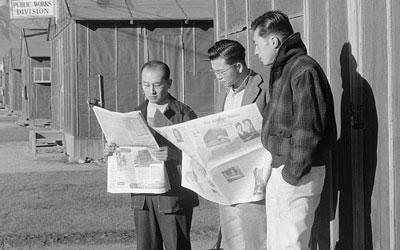
Description
This photograph is part of a larger collection given by photographer Ansel Adams to the Library of Congress. The 200 images he captured came from the Manzanar Relocation Camp in California. When presenting these images to the Library, Adams wrote in a letter, "The purpose of…
Excerpts from Korematsu v. United States, 1944
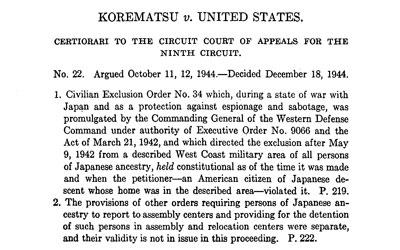
Description
The Korematsu case was brought to the U.S. Supreme Court by Fred Korematsu to challenge Japanese internment. It has been regarded as one of the worst decisions handed down by the Court. Korematsu did not initially comply with Executive Order 9066, and the subsequent 6-3…
Interview with Japanese-American Veteran Norman Saburo Ikari, December 2003

Description
This video excerpt is from an interview conducted with Norman Saburo Ikari. Ikari served in the 442nd Regimental Combat Team during World War II. In addition, all of his family, with the exception of one brother, was subject to Japanese internment. Almost 33,000 Japanese…
"Why Should We March" Flyer, 1941
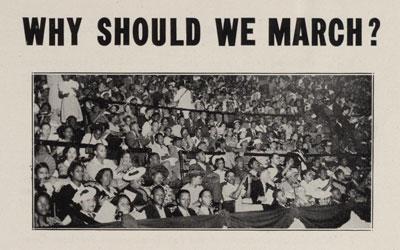
Description
The papers of A. Philip Randolph document his protests against segregation, particularly in the armed forces and defense industries during the war. Randolph led a successful movement during World War II to end segregation in defense industries by threatening to bring…
Executive Order 8802: Prohibition of Discrimination in the Defense Industry, June 25, 1941
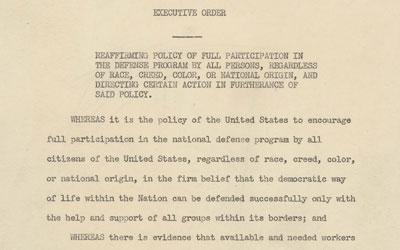
Description
In early July 1941, millions of jobs were being created, primarily in urban areas, as the United States prepared for war. When large numbers of African Americans moved to cities in the north and west to work in defense industries, they were often met with violence and…
Women Working at the Pacific Parachute Company in San Diego, California, April 1942
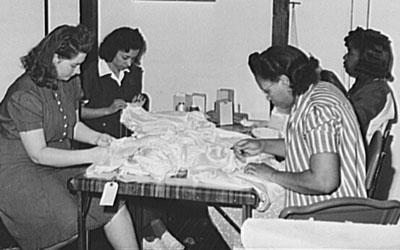
Description
The photograph shows an example of the type of workplace, in part, made possible by the Executive Order 8802. Women, one African American, one Latina and two white, are shown working together in this factory in a desegregated…
Iowa Public Television's "An Iowan Joins the Tuskegee Airmen During World War II | First Lieutenant Luther Smith," 2006
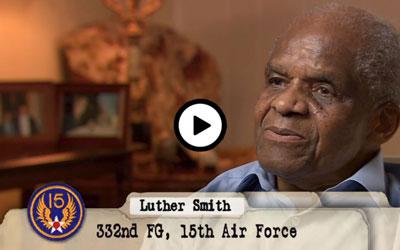
Description
The Tuskegee Airmen, officially known as the 332nd fighter group, were the first African Americans to fly planes in the U.S. military. Although they faced severe discrimination in the country and mandates of Jim Crow laws in the South, they volunteered in large numbers to…
Public School Children Buying War Bonds in Chicago, Date Unknown
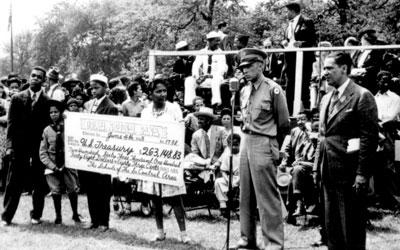
Description
The photograph shows a check being awarded to the military in the amount of $263,148.83 by children in the South Central District of Chicago. This money was earmarked to buy 125 jeeps, two planes and a motorcycle. The purchase of war bonds is something that many Americans…
Additional Resources
- "Maytag Factory, Newton IA - Changes to Support World War II" Video
This video from Iowa Public Television focuses on how the company Maytag was one of the first Iowa companies to stop producing consumer goods and start making war supplies. Their actions included hiring many women to support the war effort, too. - National World War II Museum: Home Front
This webpage on the National World War II Museum's website focuses on what was happening in the United States during the war. It includes articles, photographs and more. - The War: At Home
This website from PBS provides many resources that focuses on World War II on the ground in Europe and at home in the United States. There are articles, videos, photos and more resources to utilize. - On the Home Front
This webpage is hosted by the National Women's History Museum and focuses on women's roles in the war effort from the United States.
Iowa Core Social Studies Standards (9th-12th Grade)
Listed below are the Iowa Core Social Studies content anchor standards that are best reflected in this source set. The content standards applied to this set are high school-age level and encompass the key disciplines that make up social studies for students 9th through 12th grade.
| No. | Standard Description |
| SS-US.9-12.14. | Evaluate the impact of gender roles on economic, political, and social life in the U.S. |
| SS-US.9-12.21. | Analyze change, continuity and context across eras and places of study from civil war to modern America. |
| SS-US.9-12.24. | Critique primary and secondary sources of information with attention to the source of the document, its context, accuracy, and usefulness such as the Reconstruction amendments, Emancipation Proclamation, Treaty of Fort Laramie, Chinese Exclusion Act, Roosevelt’s Corollary to the Monroe Doctrine, Wilson’s Fourteen Points, New Deal Program Acts, Roosevelt’s Declaration of War, Executive Order 9066, Truman Doctrine, Eisenhower’s Farewell Speech, Gulf of Tonkin Resolution, Test Ban Treaty of 1963, Brown vs. Board of Education decision, Letter from a Birmingham Jail, and the Voting Act of 1965. |
| SS-US.9-12.25. | Analyze how regional, racial, ethnic and gender perspectives influenced American history and culture. |
| SS-US.9-12.26. | Determine multiple and complex causes and effects of historical events in American history including, but not limited to, the Civil War, World War I and II, the Korean War and the Vietnam War. |
| SS-US.9-12.27. | Evaluate Iowans or groups of Iowans who have influenced U.S. History. |
| SS-Geo.9-12.20. | Assess the impact of economic activities and political decisions on urban, suburban, and rural regions. |
| SS-Geo.9-12.23. | Analyze the consequences of human-made and natural catastrophes on global trade, politics, and human migration. |
| SS-WH.9-12.22. | Analyze the influence of social, political and economic developments on gender roles and social status. |
| SS-WH.9-12.24. | Examine and explain how the perspectives of individuals and societies impact world history. |
| SS-WH.9-12.25. | Determine multiple and complex causes and effects of historical events within world history. |
| SS-Econ.9-12.13. | Apply the concept of scarcity when making economic decisions. |
| SS-Econ.9-12.15. | Analyze what goes into determining, and who determines, what is produced and distributed in a market system. |
| SS-Econ.9-12.24. | Analyze how national and global economic issues and systems impact Iowa’s economy. |
| SS-Gov.9-12.13. | Evaluate the powers and responsibilities of local, state, tribal, national, and international civic and political institutions, how they interact and the role of government in maintaining order. (21st century skills) |
| SS-Gov.9-12.14. | Analyze the role of citizens in the U.S. political system, with attention to the definition of who is a citizen, expansion of that definition over time, and changes in participation over time. (21st century skills) |
| SS-Gov.9-12.16. | Evaluate how the U.S. Constitution establishes the Rule of Law, governmental powers and responsibilities, as well as limits to a government. (21st century skills) |